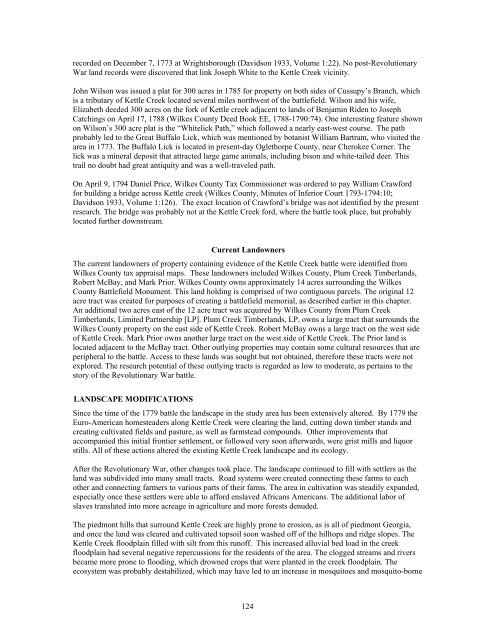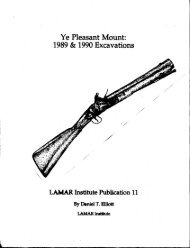Stirring Up a Hornet's Nest: - UGA Laboratory of Archaeology ...
Stirring Up a Hornet's Nest: - UGA Laboratory of Archaeology ...
Stirring Up a Hornet's Nest: - UGA Laboratory of Archaeology ...
Create successful ePaper yourself
Turn your PDF publications into a flip-book with our unique Google optimized e-Paper software.
ecorded on December 7, 1773 at Wrightsborough (Davidson 1933, Volume 1:22). No post-Revolutionary<br />
War land records were discovered that link Joseph White to the Kettle Creek vicinity.<br />
John Wilson was issued a plat for 300 acres in 1785 for property on both sides <strong>of</strong> Cussupy’s Branch, which<br />
is a tributary <strong>of</strong> Kettle Creek located several miles northwest <strong>of</strong> the battlefield. Wilson and his wife,<br />
Elizabeth deeded 300 acres on the fork <strong>of</strong> Kettle creek adjacent to lands <strong>of</strong> Benjamin Riden to Joseph<br />
Catchings on April 17, 1788 (Wilkes County Deed Book EE, 1788-1790:74). One interesting feature shown<br />
on Wilson’s 300 acre plat is the “Whitelick Path,” which followed a nearly east-west course. The path<br />
probably led to the Great Buffalo Lick, which was mentioned by botanist William Bartram, who visited the<br />
area in 1773. The Buffalo Lick is located in present-day Oglethorpe County, near Cherokee Corner. The<br />
lick was a mineral deposit that attracted large game animals, including bison and white-tailed deer. This<br />
trail no doubt had great antiquity and was a well-traveled path.<br />
On April 9, 1794 Daniel Price, Wilkes County Tax Commissioner was ordered to pay William Crawford<br />
for building a bridge across Kettle creek (Wilkes County, Minutes <strong>of</strong> Inferior Court 1793-1794:10;<br />
Davidson 1933, Volume 1:126). The exact location <strong>of</strong> Crawford’s bridge was not identified by the present<br />
research. The bridge was probably not at the Kettle Creek ford, where the battle took place, but probably<br />
located further downstream.<br />
Current Landowners<br />
The current landowners <strong>of</strong> property containing evidence <strong>of</strong> the Kettle Creek battle were identified from<br />
Wilkes County tax appraisal maps. These landowners included Wilkes County, Plum Creek Timberlands,<br />
Robert McBay, and Mark Prior. Wilkes County owns approximately 14 acres surrounding the Wilkes<br />
County Battlefield Monument. This land holding is comprised <strong>of</strong> two contiguous parcels. The original 12<br />
acre tract was created for purposes <strong>of</strong> creating a battlefield memorial, as described earlier in this chapter.<br />
An additional two acres east <strong>of</strong> the 12 acre tract was acquired by Wilkes County from Plum Creek<br />
Timberlands, Limited Partnership [LP]. Plum Creek Timberlands, LP, owns a large tract that surrounds the<br />
Wilkes County property on the east side <strong>of</strong> Kettle Creek. Robert McBay owns a large tract on the west side<br />
<strong>of</strong> Kettle Creek. Mark Prior owns another large tract on the west side <strong>of</strong> Kettle Creek. The Prior land is<br />
located adjacent to the McBay tract. Other outlying properties may contain some cultural resources that are<br />
peripheral to the battle. Access to these lands was sought but not obtained, therefore these tracts were not<br />
explored. The research potential <strong>of</strong> these outlying tracts is regarded as low to moderate, as pertains to the<br />
story <strong>of</strong> the Revolutionary War battle.<br />
BLANDSCAPE MODIFICATIONS<br />
Since the time <strong>of</strong> the 1779 battle the landscape in the study area has been extensively altered. By 1779 the<br />
Euro-American homesteaders along Kettle Creek were clearing the land, cutting down timber stands and<br />
creating cultivated fields and pasture, as well as farmstead compounds. Other improvements that<br />
accompanied this initial frontier settlement, or followed very soon afterwards, were grist mills and liquor<br />
stills. All <strong>of</strong> these actions altered the existing Kettle Creek landscape and its ecology.<br />
After the Revolutionary War, other changes took place. The landscape continued to fill with settlers as the<br />
land was subdivided into many small tracts. Road systems were created connecting these farms to each<br />
other and connecting farmers to various parts <strong>of</strong> their farms. The area in cultivation was steadily expanded,<br />
especially once these settlers were able to afford enslaved Africans Americans. The additional labor <strong>of</strong><br />
slaves translated into more acreage in agriculture and more forests denuded.<br />
The piedmont hills that surround Kettle Creek are highly prone to erosion, as is all <strong>of</strong> piedmont Georgia,<br />
and once the land was cleared and cultivated topsoil soon washed <strong>of</strong>f <strong>of</strong> the hilltops and ridge slopes. The<br />
Kettle Creek floodplain filled with silt from this run<strong>of</strong>f. This increased alluvial bed load in the creek<br />
floodplain had several negative repercussions for the residents <strong>of</strong> the area. The clogged streams and rivers<br />
became more prone to flooding, which drowned crops that were planted in the creek floodplain. The<br />
ecosystem was probably destabilized, which may have led to an increase in mosquitoes and mosquito-borne<br />
124










